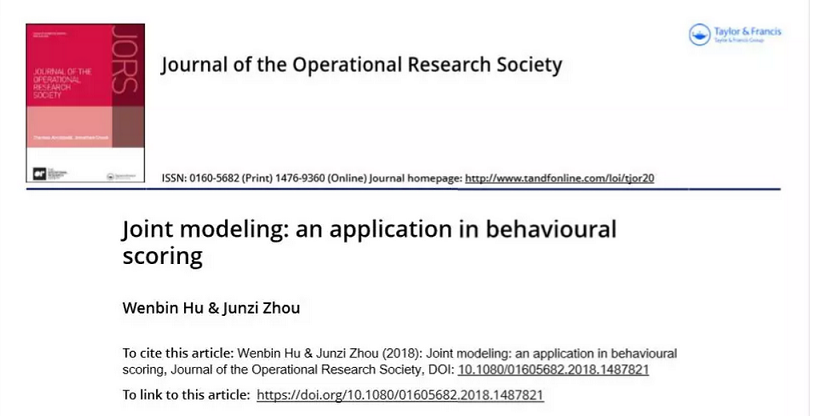近日,浙江大学互联网金融研究院(浙大AIF)数学与互联网金融研究中心(CIMF)研究员胡文彬等在SCI期刊《Journal of the Operational Research Society》发表了《Joint modeling: an application in behavioural scoring》(《生存分析联合模型及其在行为评分中的应用》)一文,选取了我国P2P平台的违约数据和美国房地美的房贷违约数据进行实证,将生存分析联合模型首次应用到信用风险评估领域,以充分挖掘并利用互联网金融大数据的优势。该项目获得了教育部人文社会科学青年基金的资助。
互联网金融的本质是金融,核心是风险控制。在众多的风控模型中,生存分析是近年热门的信用评分模型。然而,已有的生存分析模型混淆了影响个体违约的外生和内生时变变量,无法最大限度地挖掘和利用大数据中隐含的动态信息。

ABSTRACT:
Survival analysis has become an appealing approach in credit scoring. It is able to readily incorporate time-dependent covariates and dynamically predict the survival probability. However, the difference between endogenous and exogenous covariates is ignored in the existing extended Cox models in behavioural scoring. In this paper, we apply joint modelling framework, which can be seen as an extension of survival analysis, to overcome such deficiency of survival models. We carefully design experiments on two datasets and verify the superiority of joint modelling over the extend Cox model through cross validation on dynamic discrimination and calibration performance measures. The experimental results indicate that the joint model performance is better, especially in the calibration measure. The key reason for the better performance is discussed and illustrated.
摘要:
生存分析是一类重要的信用评分模型。最典型的生存分析模型是Cox模型,可以处理时变的解释变量并动态地预测个体的违约概率。然而,已有的生存分析模型混淆了影响个体违约的外生和内生时变变量,无法最大限度地挖掘和利用隐含的信息。本文提出的生存分析联合模型是生存分析模型和纵向数据模型的结合,可以很好地区分模型的内、外生变量,适用于处理基于动态数据的行为评分。本文分别选取了我国P2P平台的违约数据和美国房地美的房贷违约数据进行实证,结果表明联合模型能更充分地利用内生变量的变化信息,并对违约概率做出更准确的预测。
点击阅读原文查看完整论文

